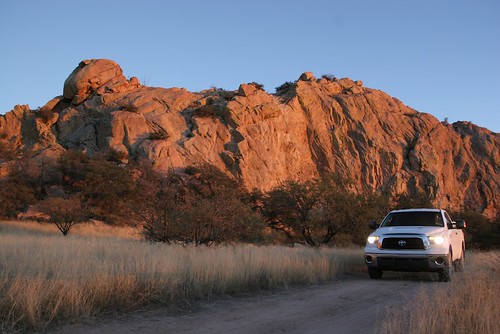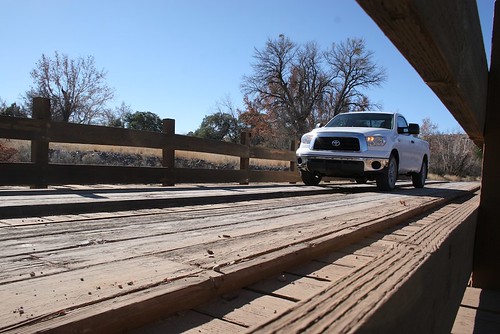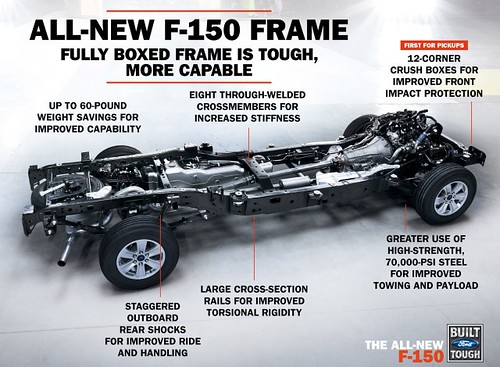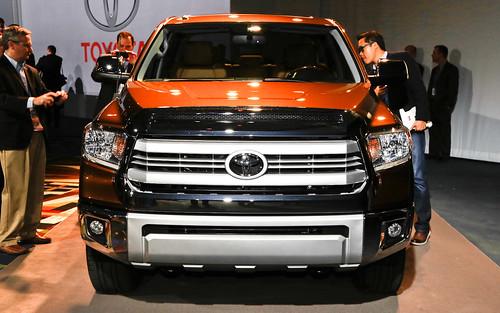The 2015 F150 should have been the 2014 Tundra
 The 2008 Tundra . . . shrug.
The 2008 Tundra . . . shrug.
I’ve been about as loyal a Toyota fan as one could imagine for a long, long time. My first car was a 1971 Corolla with the nifty little overachiever 1600cc hemi-head engine. The car was chosen, to be honest, as much to annoy my stepfather (who still referred to people from the islands as “Nips”) as for any practical reason. The fact that that second-hand car proved spectacularly reliable in contrast to the new Ford Pinto station wagon my mother had at the time just made it so much sweeter. With suspension from the infant Toyota Racing Development and a set of Weber carbs, my Corolla embarrassed many a BMW 2002 and Z-car on Mt. Lemmon Highway.
In 1978 I bought the ’73 FJ40 that is still with me 300,000 miles later. Nuff said. And there has been a succession of Toyota pickups culminating in the 2012 Tacoma Roseann and I now have. All have been as reliable as the Corolla. The 2000 Tacoma we had under our first Four Wheel Camper required no repairs in 160,000 miles. Zero. So I’ve come to expect, and have enjoyed, utter dependability from the company’s products.
Innovation? Lately, not so much—at least if we’re discussing full-size trucks.
I remember the buzz surrounding the announcement of Toyota’s first “full-size” truck, the T-100, in 1993. When it finally arrived, officials at Ford and GM must have breathed a sigh of relief, if they didn’t laugh out loud—it wasn’t full-sized, and the base engine was . . . a four-cylinder? While the T100 proved as reliable as other Toyotas, and acceptably powerful with the optional V6, it was clearly a false start. So in 1999, its successor was announced with much fanfare and a proper full-size-truck name: the Tundra, as big as all outdoors.
Except, of course, it wasn’t. Yes, it was bigger than the T100, the four-cylinder was gone in favor of a base V6 and an optional proper V8, but the Tundra remained firmly in the unofficial mid-sized truck category. Again it was a workhorse—I know owners with 300,000-mile examples that have never been touched—but it did nothing to directly challenge American hegemony in the big-truck market.
Cue 2007. The second generation Tundra arrived, and . . . it was big. At last Toyota had a genuine full-sized truck, positioned to compete head-on with the best from Ford, GM, and Chrysler. Three hundred eighty horsepower, a 10,000-pound tow rating, available eight-foot bed. Watch out, Big Three.
Or not. I had a chance to review a four-wheel-drive standard-cab Tundra with the 5.7-liter V8 in 2008. There was no denying its impressive size—far too large for my tastes unless I’d also had my dream sailboat to tow with it. But it stood shoulder to shoulder with American trucks, and had the paper specs to compete.
In looking at the window sticker for features, I noticed the chassis described as a “Triple-Tech Frame,” which I assumed was a reference to an updated version of Toyota’s typical fully boxed chassis construction. I peered under the bed, and did a double take. There was no boxing at all under the bed, and only token bits under the front. This was a cheap open C-channel frame that would have looked right at home under a ’73 Ford pickup—the ones you see with side chrome strips about three inches apart where the cab meets the bed. As my English friends would say, I was gobsmacked. For years I’d been preaching the superiority of Toyota’s chassis construction, and here they’d abandoned it for 50-year-old technology and a fancy name. (My impressions were confirmed by THIS alarming video. Just watch it.)

I spent a week with the truck, and . . . it worked just fine. The power was impressive, ride and handling were decent, the interior was okay, if short of the perfect ergonomics I associated with the company (perhaps because I just felt like a Hobbit perched on the seat). Ground clearance was comically inadequate; front air dam contact was inevitable on any but the mildest trail.
When I turned in the keys, I found that my overall reaction to this, Toyota’s broadside at the best-selling vehicles in the United States, its weapon to muscle in on the most iconic American object there is, the pickup truck, was . . . a shrug of the shoulders. There was nothing—simply nothing—I could see that would convince a loyal owner of an American truck to switch brands. No breakthroughs in technology, power, comfort, or economy. If Toyota expected to gain any market share at all except from a relative few owners of small Toyota pickups who found themselves needing a larger one, I predicted failure. Indeed, by 2012 Toyota’s share of the full-size truck market was stuck in the mud at around six percent. (Meanwhile the Tacoma commands well over 50 percent of the compact truck market in the U.S., outselling its nearest competitor by two to one.)
In the last couple of years there has been an avalanche of news about redesigned full-size trucks, with stunning advancements in technology. RAM introduced a sophisticated coil-spring rear suspension and announced a new turbodiesel engine that should catapult fuel economy figures into the high 20s. And Ford has completely rewritten the full-size-truck rule book with its 2015 F150, which will incorporate extensive use of aluminum, including the cab and bed. Incidentally, the chassis of that F150 is not only fully boxed, the crossmembers extend all the way through the boxed side rails and are welded on both sides. Now that’s the way to build a truck frame.

Along the way, I got a news item regarding the redesigned 2014 Tundra. Would this be the one? I clicked on the item, and found that the 2014 Tundra had indeed been thoroughly worked over, end to end.
Or rather, end and end: It had a new grille. And “TUNDRA” is now embossed on the tailgate, in letters as big as all outdoors.
In between? Pretty much zip.
 Thanks, Toyota.
Thanks, Toyota.
There’s a crude colloquial expression I could use here to urge Toyota to either get serious with the Tundra or abandon the segment altogether, but I’ll refrain. Nevertheless, I think the company needs to do one or the other.
 What it should have been.
What it should have been.
Hmm . . . HERE is an intriguing bit of news, courtesy my friend Bill Lee. A five-liter turbodiesel option would solve half my problem with the Tundra. A decent chassis would solve the other half . . .
